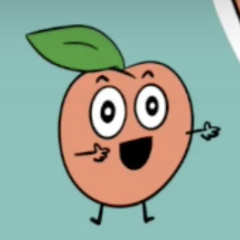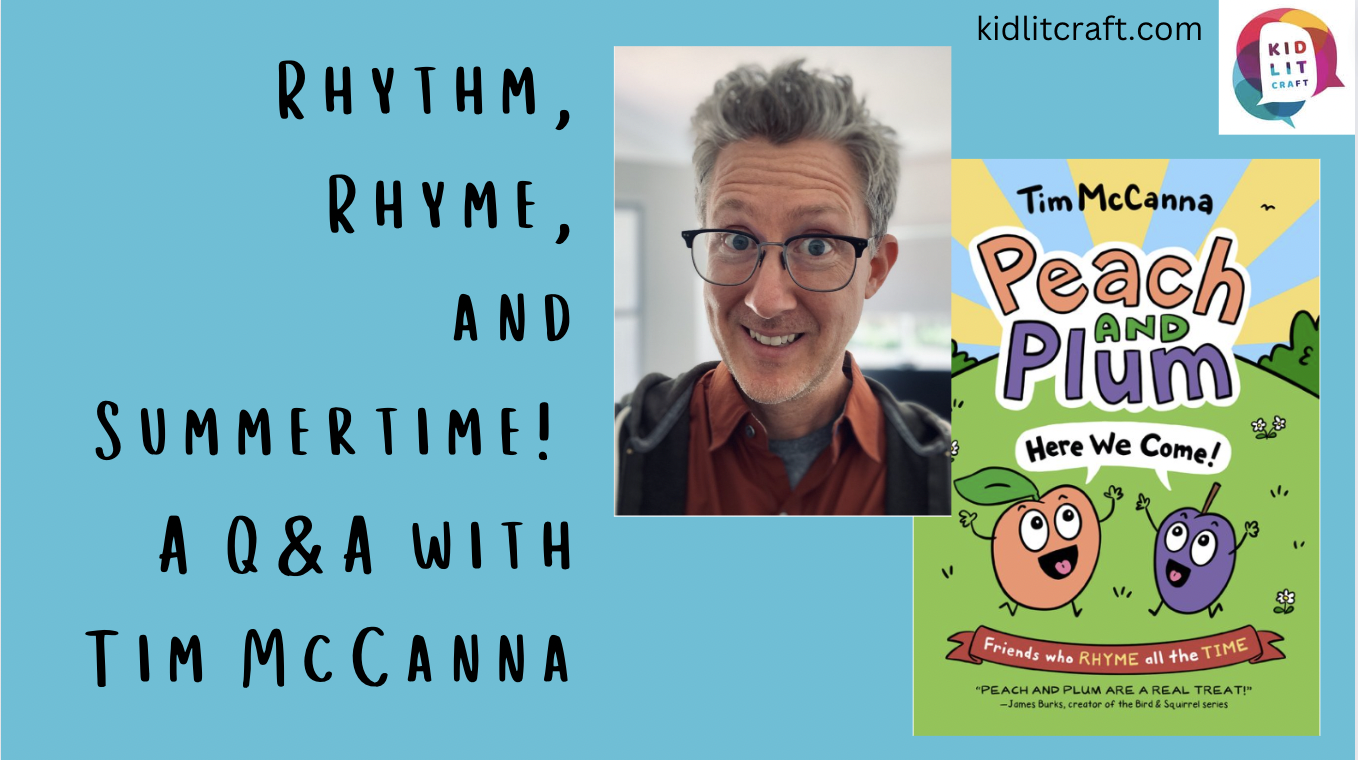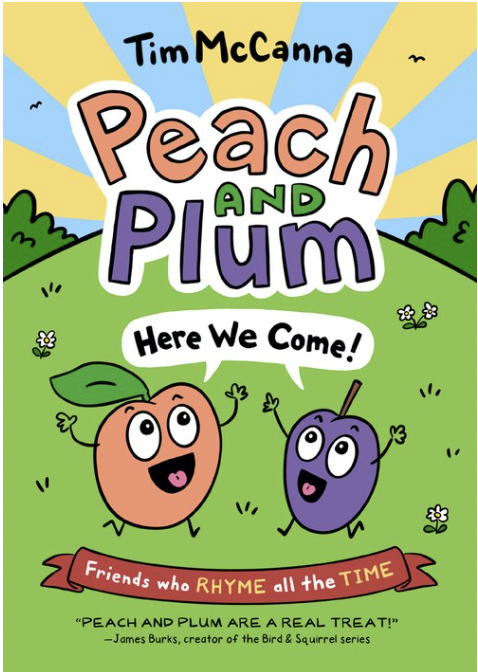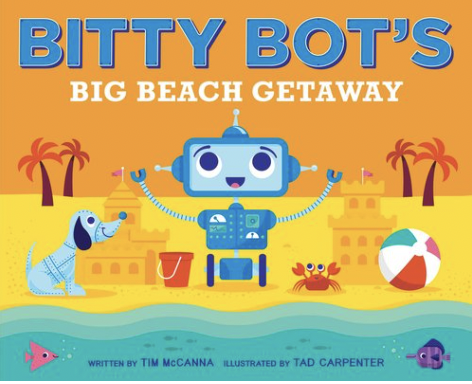interview by Anne-Marie Strohman
I met Tim McCanna early in his picture book writing career, and his enthusiasm for all things kidlit was infectious. His enthusiasm and curiosity shine through in his books, school visits, book launches, speaking engagements, and videos. As a former theater kid (and adult), and a musician and songwriter, Tim has a flair for telling stories with language that engages child (and adult) readers from the very first page. His list of picture books is long and varied (you’ll see some below), and his first graphic novel for early readers–which he illustrated himself–came out earlier this year. I got to ask Tim about his process, as well as advice for authors attempting rhyme. Read on to see a master at work. –Anne-Marie
KidLit Craft: Peach and Plum, Here We Come! is your first book with two main characters. How was the process of writing a two-main-character book versus having one main character? (I should note that many of your books are concept books and/or have a large cast of characters.)
Tim McCanna: You know, you’re right! My stories have often been about single characters like Bitty Bot and Jack B. Ninja. But I’ve always wanted to write a “buddy book” about two characters having fun and getting into trouble, like Frog and Toad or Ivy and Bean. Having that friendship dynamic definitely offers new kinds of storytelling opportunities, especially when the friendship is tested. And though my writing process didn’t change much—other than illustrating for the first time!—what I did find was that Peach and Plum’s individual personalities emerged as I put them into various scenarios together. Plum almost immediately revealed himself to have wilder mood swings, while Peach was the calmer of the two. Having two main characters gives me opportunities to use dialogue and physical interactions to reveal their personal traits while pushing the plots through at the same time.
KLC: The book also features RHYME (as Plum tells us early on). But for me, more impressive than your rhyme is your RHYTHM. How do you go about making sure each line has the correct rhythm? Does it come intuitively, or is it something you work on?
TM: Thanks! A bit of both, I guess. After writing songs, poems, and picture book texts for so many years, perhaps I’ve developed an inner ear for meter. I find I can sort of self-edit on the fly as I’m writing a first draft. Sensing if you’re on the right track comes with experience. Trusting your intuition has to be earned by running into a lot of roadblocks and successfully finding your way through them. That’s true for any kind of writing. On the other hand, sometimes you just have to grind it out. Meter takes work, that’s for sure. Most of the dialogue is a back and forth between Peach and Plum in very short sentences; one to four words long. If we want to get really granular, the book is in iambic tetrameter:
Hey Peach / What’s up? / Not much / And you?
Oh Plum / Ho-hum / I’m bored / Me too!
Keeping their sentences so short really helped me find and maintain the rhythm through the whole book. And, those shorter sentences are great for young kids who are just starting to read on their own. It’s a win-win!
KLC: Why fruit?

TM: I had the title of Peach and Plum rattling around in my head for a long time. It was buried in a list of potential story ideas I keep handy. But when I finally sat down to work on it, I realized that I was writing a graphic novel script and not a picture book manuscript. That’s when I faced a decision. Could this be the project I try to illustrate myself? I figured that for my first go at it, perhaps drawing consistent fruit shapes in different poses and from different angles might be a little easier than drawing animals or people. Since there are so many types of fruit, it offers me a whole cast of oddly shaped characters in a rainbow of colors, each with their own distinctive personalities. Oh yeah—and kids love talking food!
KLC: The book is structured with an introduction and a conclusion, and with five main chapters and five “half” chapters–which are little entr’actes, really two- or four-page comics. How did you develop the structure? What inspired this structure?
TM: Right from the start, I knew I wanted an episodic feel to the book, where each little story stands alone. It was July 2020 when I started, so I guess my head was in a summery place. I brainstormed typical summertime childhood activities like playing ball, riding bikes, and going to the beach. Story ideas like one about flying a kite warranted a full chapter. But I had a few topics like dropping your ice cream on the ground, getting bubble gum on your face, or camping in the back yard that felt like quicker moments, so I used those to break up the bigger chapters. Childhood friendships are full of both big and little experiences, so it was fun to explore them all for Peach and Plum.
KLC: When you’re working on a book in rhyme, how do you approach it? Do you start in rhyme? Outline? Start in prose? How do you get to the story?
TM: When I get an idea for a rhyming text that excites me, whether it’s a title or a concept or a scenario, I usually do a quick stream of consciousness pass first. I just let every idea that comes to me out onto the page without judgement. I also do this so I literally don’t forget the best ideas that come to me! Some of it rhymes, some of it doesn’t. Sometimes the ending comes first. Sometimes I break off into making long lists of key words that pertain to the topic and then try to find good rhymes for those and incorporate them into sentences. I listen to the rhythms of the sentence fragments that feel the most natural and start to hone in on a meter. So, that first document is a big mess! But hopefully within that mess, there might be a rhyming couplet or two that stand out and I can then start to shape more couplets with that structure in mind. That works especially well for concept-driven ideas. When it comes to more character-driven stories, I’ll go in with a general plan for the story structure, but I often find that once I discover fun rhymes, those can end up influencing the direction of the story. So, I try to stay open to the unexpected.
KLC: I love the themes of not giving up and having a growth mindset that show up in Chapters 1 and 2. I also love in Chapter 2 how Plum is so discouraged about falling on his bike ride, and then can’t wait to ride again. It’s very kid-like! How did you think about modeling behavior for kids vs. describing typical kid behavior?
TM: Both of those chapters came straight out of my own childhood experiences! I played so many baseball games with the neighbor kids that would almost always devolve into rowdy debates. And I have vivid memories of crashing my dirt bike numerous times. But we never stopped playing ball games, and we definitely got back on our bikes after wipeouts. For Peach and Plum, I like showing how innocent moments can suddenly become complicated. The stories would be boring if everything goes fine and dandy. So, throwing in a little conflict or problem solving only strengthens the characters and their stories.
KLC: You have many books about sounds–Watersong, Dinosong, Barnyard Boogie, So Many Sounds–how did sounds come into play in writing Peach and Plum?
TM: What I love about writing early graphic novels is how simple and streamlined the storytelling is. I don’t have to tell the reader anything! It’s all there in the dialogue and the illustrations. So, every now and then I can use a sound like Ker-plop! or Crash! to punctuate a moment without needing to explain a thing. Adding sound or any other sense like taste or smell to storytelling can really help bring the world to life.
KLC: You shared on your Facebook page and YouTube channel a number of videos on your creative process. In Episode 6, you talk about mentor texts and how you used them. Was there a particular mentor text you kept at hand? What drew you to it?
TM: When I first started dabbling with illustrating, most of the graphic novels I had in my home library at the time weren’t necessarily “early reader” graphic novels. I had books like Smile, Roller Girl, El Deafo, Space Dumplins, and Sidekicks. I’d say those are more middle grade. It was my agent, Caryn Wiseman, who suggested I look at books like Narwal and Jelly and Baloney and Friends. As soon as I did, a lightbulb went off in my head and I realized that my particular voice, sensibility, and illustration style were much more suited for the “emerging independent reader” audience. Funny how now and then it takes a nudge from a friend or trusted colleague to put you on the right path.
KLC: I’ve been lucky enough to be at one of your book launches, and you are so engaging in your presentations–kids are rapt. Any advice for authors on creating a school visit program or planning for a book launch event?
TM: I have a theatre background, so it’s hard for me not to feel like I’m putting on a show when I’m in front of a crowd. I carefully plan out the beginning, middle, and end of the event and try to keep things moving with music and games and interactivity. When kids are engaged, they speak up, which is awesome. I try to keep a “Yes, AND…” attitude no matter what they throw at me, rather than ignoring them or shutting down a weird question. And oftentimes when I respond with “Yes, AND…” it leads to some of the more spontaneous and memorable moments that I hadn’t planned for. Plus, it enables those kids to feel like they are contributing to the experience.
KLC: How has the KidLit community been a part of your writing journey?
TM: It’s been vital! In the early years when I was still learning the ropes and finding my voice, I discovered so much by attending local one-day workshops and regional SCBWI conferences. When I started volunteering for my SCBWI chapter, I gained confidence in myself and expanded my experience beyond writing, while also meeting so many industry professionals. My connection to the KidLit community led to my long-term critique group, finding an agent, getting published, and landing some work-for-hire writing jobs, too. Now, I run mentored critique groups and create video courses for Storyteller Academy, which has been an exciting resource for new waves of KidLit creators. This industry is a community of teachers and artists and people who love making books for kids. I can’t think of a better group to be a part of.
KLC: Do you have any tips for writers writing in rhyme?
TM: If you want to write rhyming picture books, you have to read rhyming picture books. Lots and lots, all of the time. It has to be a part of your weekly creative process. Go to the bookstore or the library and read a dozen rhymers written in the past five years or so. Take note of the word count on each spread. Watch for how page turns contribute to the storytelling. Observe what is said—and not said—in the text versus what is seen in the illustrations. Listen to the meter and the flow of the language. Rhyming is so much more than finding words that sound alike and sticking them on the ends of sentences. This kind of wordplay adds a whole extra level of complexity to the already challenging craft of writing for kids. But when it works, it’s like magic.
KLC: And writing for the youngest readers?
TM: For some early reader books, there’s a real science to choosing vocabulary, word frequency, and sentence structures. While writing the text for Peach and Plum, I trusted my gut and just tried to tell entertaining stories using snappy dialogue while always keeping my audience in mind. We often say, “Don’t talk down to kids” and “Avoid teaching and preaching,” which is great advice. But we still need to tap into our inner child and connect with young readers on their level. So it’s all a bit of a balancing act! At the end of the day it comes down to solid storytelling with memorable characters.
KLC: What’s next for Tim McCanna fans?
TM: Oh boy, well, Peach and Plum Rule at School! arrives in February 2023. The first book is all about summer, and Book 2 is all about life at school. It really takes Peach and Plum to the next level. I also have a Disney book coming out in 2023, the year Disney celebrates their 100 year anniversary! It’s called How Far You’ll Go, and features beautiful artwork of inspiring scenes from over a dozen different Disney movies ranging from Pinocchio to Encanto. And finally, I have a new rhyming nature-themed picture book slated for 2024, so watch for that official announcement in the near future!

Tim McCanna is the author and illustrator of the Peach and Plum early graphic novel series. He has also written several picture books, including Bitty Bot’s Big Beach Getaway, an ALA Golden Duck Notable Picture Book, In a Garden, a Bank Street Best Children’s Book of the Year, So Many Sounds, an ALA-Children’s Book Council “Building a Home Library” book, and Watersong, a New York Public Library Best Book for Kids and NCTE Notable Poetry Book. Tim served five years as Assistant Regional Advisor for SCBWI’s San Francisco/South chapter, and he is a picture book specialist for Storyteller Academy. He lives with his family in San Jose, California.
For more about writing for the youngest readers, check out these author interviews!
Anne-Marie Strohman (co-editor) writes picture books, middle grade novels, and young adult short stories and novels. She is trained as a teacher, an editor, and a scholar, specializing in Renaissance Literature. She holds an MFA in Writing for Children and Young Adults from Vermont College of Fine Arts and is an active member of SCBWI. Find her at amstrohman.com and on Twitter @amstrwriter.




COMMENTs:
0